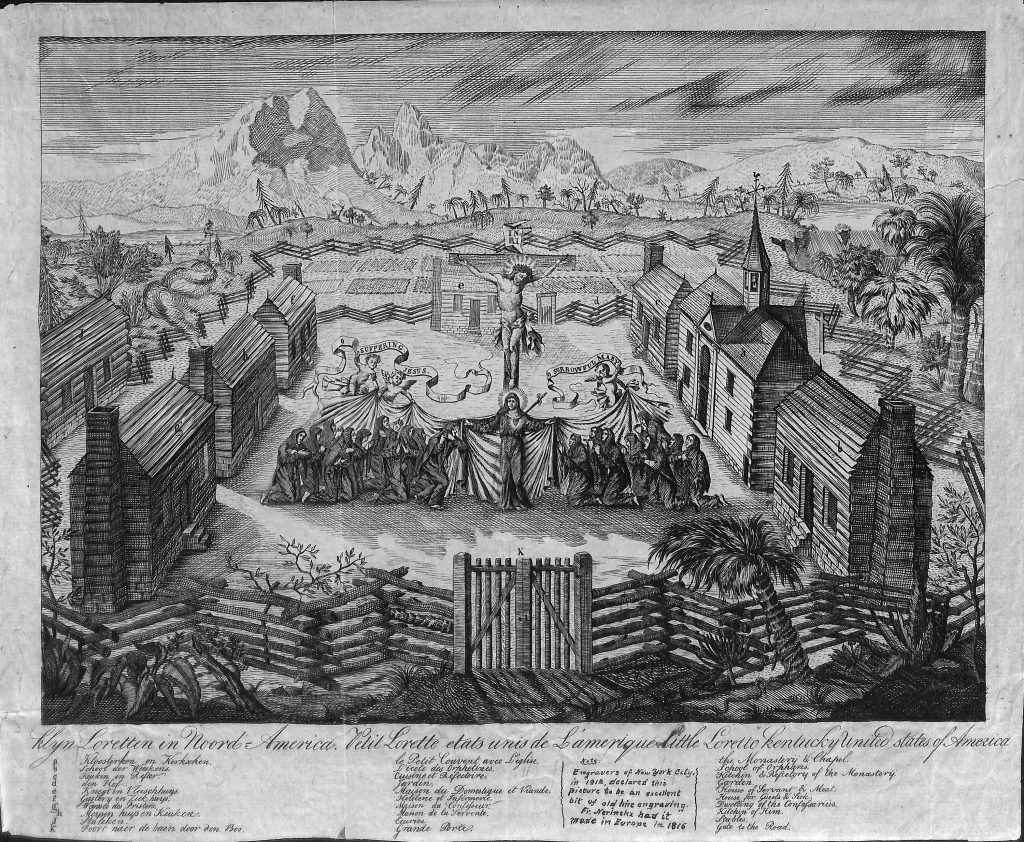The Folk Architecture of Little Loretto
Posted on November 1, 2018, by Joy Jensen SL

Courtesy of Loretto Archives
Little Loretto (the first Loretto Motherhouse, located near St. Charles, Ky.) is an example of Upland South folk architecture in early 19th century Kentucky. Folk architecture is architecture built for local people, by local builders, using local materials.
Father Charles Nerinckx raised money through subscriptions for property near St. Charles Church for the “monastery.” Neighbors donated cut logs. Father Nerinckx laid out the plan for the compound, which would have two rows with three double cabins facing each other. Each double cabin was called a “dogtrot” because there was enough space for a dog to trot through the passage between the two pens. A one-room cabin was called a “pen.” A roof covered the entire area.
There was to be a square yard in the center cleared of trees and brush and sown with bluegrass. A square cross would be erected in the center. Father Nerinckx engaged Francis Melton, a tradesman from Washington County, Ky., to build three double cabins for $60 in cash and $60 worth in trade, such as whiskey, cattle or pork.
The convent and church were in the second building on the right-hand side. The plan was to have two, two-story single pens with a passage in between. One two-story single pen was to be the church and the other the convent. The insides of the pens would be hewn smooth and plastered with a mud mortar between the logs. There was to be an 8-foot ladder to the second story. A window of eight panes of glass with a shutter would be in the side gables. The corners of the pens were squared off. There would be a door and two windows with nine panes of glass for both pens. The convent and the chapel were not finished for two years, but the passage was enclosed and weather-boarded in. This area was used as an oratory until the buildings were finished. The puncheon (logs split in half with flat side up) floors were to be at least 1-and-one-half feet above the ground, anchored by wooden timbers called sills. The area between the ground and the sills was filled in with stones from nearby Hardin’s Creek, mud and straw. Hewn steps would go up to the passage in the front and back.
Roofs were covered with three rows of oak boards. The firebox and hearth were 3 feet on the sides. The base of the chimney was made of stone, 4 feet wide, and the walls of the chimney were at least 6 feet high, above the roof by 2 feet.
Father Nerinckx himself built his dogtrot, the first building on the left-hand row, for $6.50.
The school house was to be the first building from the entrance on the right-hand row. The kitchen, workroom/infirmary and the refectory (dining room) were built later. A single pen in the third side of the square was later built as a meat-house. A zigzag split-rail wooden fence would surround the compound. The stables and outhouses would be constructed at a distance. A cemetery was to be set aside behind the chapel. Father Nerinckx cleared land behind the square for a garden and an orchard. In 1814 Father Nerinckx found two cook stoves for the sisters for $100, the first cook stoves in Washington County.
Little Loretto was unusual for the day for its planning, but the dogtrots were examples of folk architecture in early 19th century Kentucky. The women living there were self-reliant, persevering, pioneering in spirit, deeply spiritual and faithful to mission. That is a tremendous legacy for the Loretto Community and its evolution in the 21st century. It is a constant reminder of who we are to be as a Community.
Sources: Joan Campbell, Loretto: An Early American Congregation in the Antebellum South; C. Furnas, The Americans: A Social History of the United States; W.J. Howlett, Life of Rev. Charles Nerinckx; Camillus P. Maes, Life of Charles Nerinckx; D.W. Meinig, The Shaping of America: A Geographical Perspective; William Montell and Michael Morse, Kentucky Folk Architecture.
